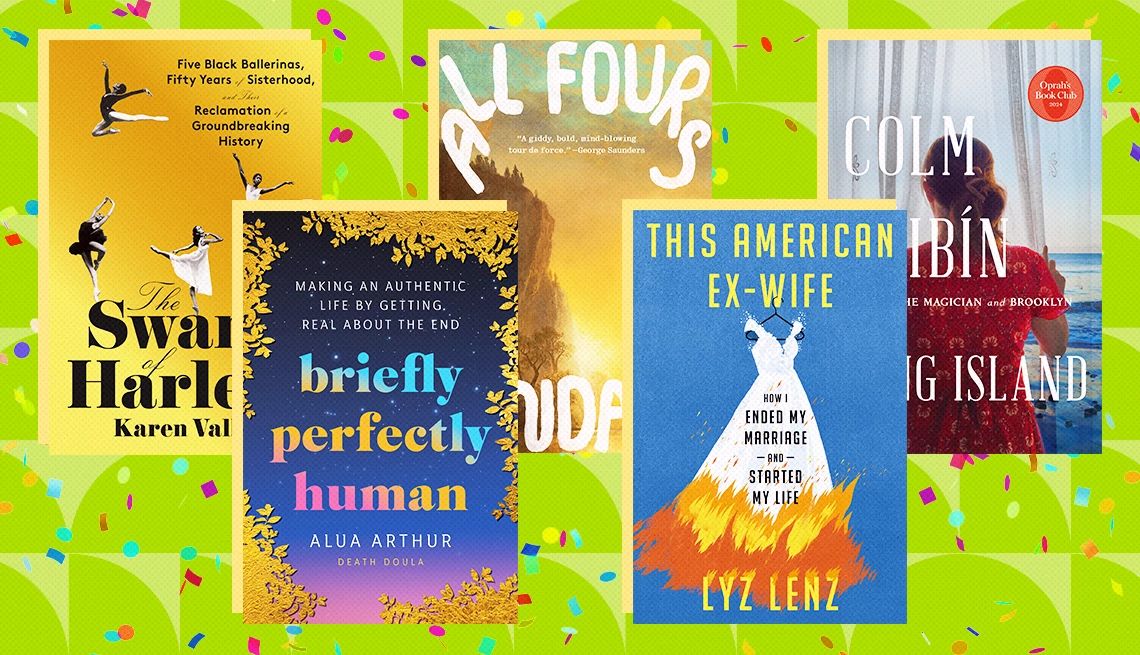Long Island by Colm Tóibín
Fifteen years after his 2009 novel Brooklyn (turned into a 2015 movie starring Saoirse Ronan), Colm Tóibín brings back Eilis Lacey, now living on Long Island with her husband, Tony, and two kids — an Irishwoman surrounded by a close-knit clan of Italian American in-laws. After a betrayal, she takes an extended trip to see her mother in their small Irish hometown, a community where everyone knows your business — including the fact that Eilis and local bar owner Jim were in love before Eilis mysteriously fled 20 years earlier. The quiet, moving story is told from the perspectives of different characters, each with a heartbreaking inability to express what they truly desire. Note that you don’t need to have read Brooklyn (I hadn’t) to enjoy this follow-up.
"The Swans of Harlem: Five Black Ballerinas, Fifty Years of Sisterhood, and Their Reclamation of a Groundbreaking History" by Karen Valby
Courtesy Pantheon Books
The Swans of Harlem: Five Black Ballerinas, Fifty Years of Sisterhood, and Their Reclamation of a Groundbreaking History by Karen Valby
Netflix has already optioned the rights to this biography of a trailblazing group of five ballerinas — Lydia Abarca, Gayle McKinney-Griffith, Sheila Rohan, Marcia Sells and Karlya Shelton-Benjamin — who began performing with the Dance Theatre of Harlem in 1969. Author Karen Valby describes the range of challenges they faced while breaking down barriers, including a lack of public recognition, which she tries to remedy in this deeply researched telling. She interviewed all five dancers, who have been friends for half a century (a relationship highlighted in her 2021 New York Times story, which inspired the book after it went viral).
"How the Light Gets In" by Joyce Maynard
Courtesy Harper Collins
How the Light Gets In by Joyce Maynard
Maynard, 70, is the author of the bestselling memoir At Home in the World and novels such as To Die For and Labor Day (and is also known for her brief relationship with the author J.D. Salinger). This brilliant, moving story is a kind of sequel to her 2021 novel Count the Ways, which you don’t need to have read to become absorbed in this one. It’s centered around Eleanor, now in her 50s, who has moved from Boston back to the New Hampshire farm where she and her ex-husband, Cam, raised their family, to care for the dying Cam and live with her brain-injured adult son, Toby. Over a 15-year span, she wrestles with a baffling estrangement from her oldest daughter, along with guilt and resentment over the long-ago accident that injured Toby, while falling into a passionate but unfulfilling affair. And yet, as she ages, we see her begin to appreciate the love and beauty that her life holds despite (or because of) its many disappointments and apparent wrong turns.
"This American Ex Wife: How I Ended My Marriage and Started My Life" by Lyz Lenz
Courtesy Penguin Random House
This American Ex-Wife: How I Ended My Marriage and Started My Life by Lyz Lenz
Lyz Lenz, a writer who divorced after a soul-sucking 12-year marriage, makes a controversial but unapologetic argument: Marriage as an institution is inherently flawed because it’s structured for men’s benefit. But not all marriage. “The sacred cow I’m slaughtering for steak and eating with a nice red wine is that of heterosexual marriages. And I am doing it from the perspective of the partner who is always asked to carry more than their fair share,” she writes. It’s easy to see why she left her ex. Besides expecting her to cook and clean for him, the guy did obnoxious things, like hide some of her favorite objects (quirky mugs, a copy of Madame Bovary). She couldn’t figure out why she kept losing her stuff until she found the items in a box in the basement. But you don’t need to want to leave your own marriage or burn your wedding dress — as she does, with joy, after her divorce — to appreciate the questions she raises about why and how we couple. It certainly wouldn’t hurt anyone to consider them before saying “I do.”
"Feeding Ghosts" by Tessa Hulls
Courtesy Farrar, Straus and Giroux Books
Feeding Ghosts by Tessa Hulls
Even if you’re not usually drawn to graphic books, this heartfelt graphic memoir demonstrates how special they can be. Tessa Hulls, who was born to an English father and Chinese mother and raised in a tiny California town, uses a mix of text and evocative black-and-white drawings to describe her research into her family’s dramatic story through three generations of women. It begins with her late Chinese grandmother, Sun Yi, a Shanghai journalist persecuted for years for her anti-Communist writings until she fled with her young daughter Rose (Hulls’ mom) to Hong Kong in 1957. Sun Yi suffered from mental illness, shaping Rose, who was an emotionally repressed, fearful parent to Hulls. The process of uncovering and understanding her family’s painful past to create the memoir, she suggests, has allowed her to placate the ghosts of history that her grandmother and mother so feared. But “they never wanted to devour us,” she concludes. “They just wanted to be known, to have their story heard.”

















































































You Might Also Like
Favorite Streaming Shows of 2024
From the historical romance hit ‘Bridgerton’ to the comedy ‘Hacks,’ here are our top picks of the first half of the year
Favorite Network Shows of 2024
‘Shōgun,’ ‘Abbott Elementary,’ ‘The Good Doctor’ and more, check out our top picks of the first half of the year
Favorite Reality Shows of 2024
‘Survivor,’ ‘The Traitors’ and ‘The Bachelor’ come out on top; see what else made our list for the first half of the year
Recommended for You